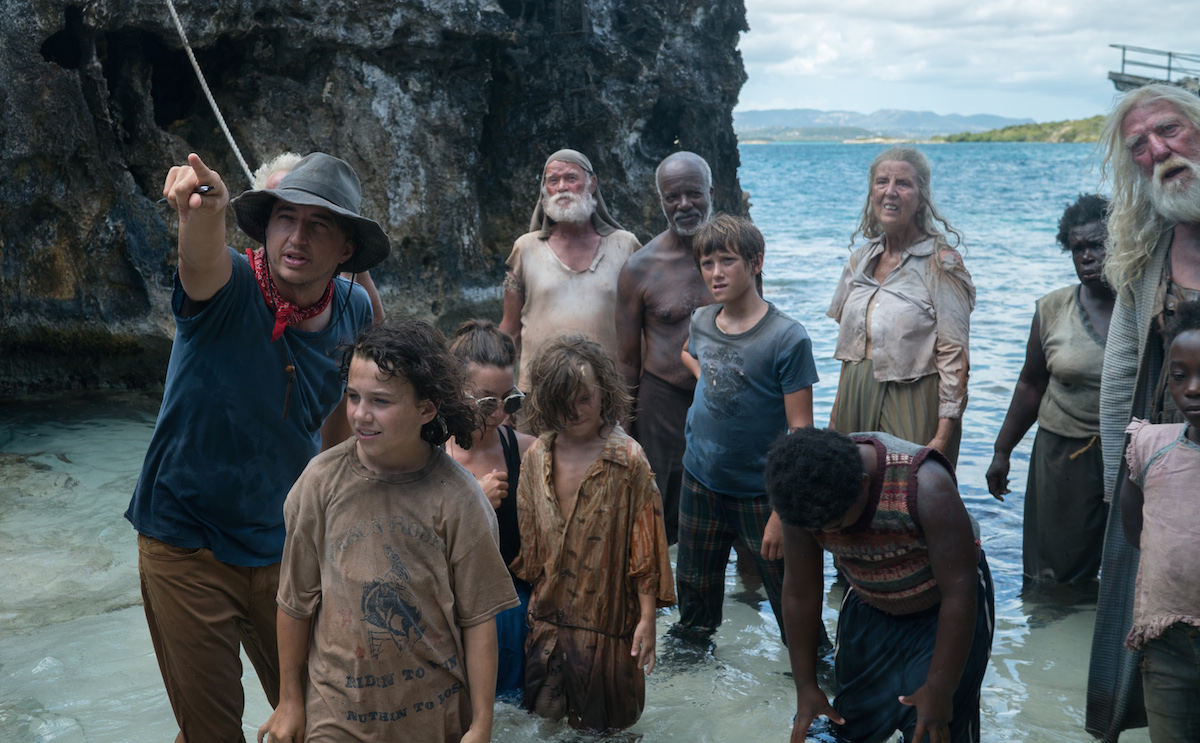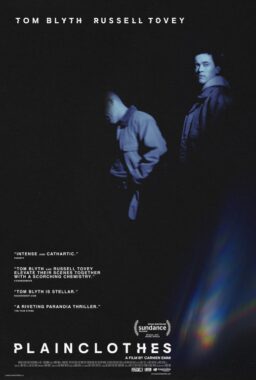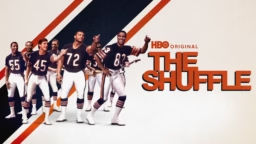When Hushpuppy (Quvenzhané Wallis) declares that she’s “The Man” in Benh Zeitlin’s Oscar-nominated 2012 debut feature, “Beasts of the Southern Wild,” it doesn’t matter that she’s a six-year-old girl with a dying father and a submerged hometown. The sheer force of her determination, personality and indomitable strength make her unmistakably The Man in every sense, and the same could be said of Yashua Mack, the six-year-old who embodies the ageless sprit of Peter Pan in Zeitlin’s long-awaited second directorial effort, “Wendy.” As the titular 10-year-old heroine, newcomer Devin France anchors every frame with her unquenchable thirst for adventure, as well as the awe and curiosity that shine through her eyes.
Like one of my favorite films from my youth, Agnieszka Holland’s 1993 adaptation of “The Secret Garden” (gorgeously shot by Roger Deakins), the palpable magic in “Wendy” springs primarily from the landscape itself, which in this case just so happened to feature an active volcano (located on the island of Montserrat in the West Indies). Sturla Brandth Grøvlen, cinematographer of 2015’s one-take wonder “Victoria,” has a spontaneity and exuberance akin to the children themselves, while the script co-authored by Zeitlin and his sister Eliza finds unexpected ways of incorporating the beloved imagery and themes from J.M. Barrie’s immortal tale. During a recent visit to Chicago, Zeitlin spoke with RogerEbert.com about his own fear of growing up, his love of producing and why he considers this film a protest of mainstream American cinema.
When I interviewed you back in 2012, you told me that each film you make develops out of the previous one. In what ways did your experience filming “Beasts” inform the seven-year journey of making “Wendy?
There was a real continuity to it. We started making the film right after “Beasts.” I had talked about doing this one next at Sundance, and a lot of it was sort of linked to my experience with Quvenzhané Wallis, going from when I met her when she was 5, shooting the movie when she was 6, and then going out on the road doing press, our whole journey to Hollywood and all of the crazy things that happened there. I saw this parallel experience that we were having. When you’re six, it’s very, very different from being eight or nine. You are totally not self-conscious and you have no sense of your actions having consequences. That realization only starts to hit you as you get older.
I had made “Beasts” with family and friends in this sort of utopian state off the grid in South Louisiana, not thinking that anybody was going to see the movie. For me, going from working with this group that for whom creative freedom was everything, to facing what was going to come next now that the world had seen and embraced what we had made, was a similar journey. How you maintain your freedom when that change starts to happen evolves over time. That tension between caring and being free felt really pressing. It’s a universal question that everybody experiences and deals with as they age, and I realized that connected with the character of Peter Pan, whom my sister Eliza and I had wanted to make a film about our entire lives.
The very first scene where baby Wendy hands out napkins to customers at her mother’s restaurant made me recall how Wallis, at the Chicago press meet and greet for “Beasts,” went around cleaning all the tables.
She would always do that! [laughs] In Wendy’s case, she saw those napkins as toys. She saw what the adults were doing, and figured they were playing, so she decided to join them.

There seems to be a through line in Dan Romer’s marvelous scores for “Beasts” and “Wendy,” considering they both represent the inner life of each film’s young heroine.
Both scores are built around a similar idea. “Wendy” is so much about freedom and what it means to this little girl. She doesn’t have a bad life at the beginning of the movie. It’s not like she’s coming out of an orphanage or has an evil stepmom, but she has this desire to be wild and free in a way that normal life doesn’t allow her to be, and for a lot of us to be. So one thing that Dan and I thought a lot about was the idea of pioneers going on adventures. When Wendy is playing in the mud and running around in the woods, she’s not doing anything that spectacular. There’s no war going on or anything like that. But we wanted her to have this theme that is evocative of horses blazing into the sunset, or stagecoaches charging into the unknown, into the wild. For her, just getting to jump into the mud and slide around and laugh and pour water on someone—that is ultimate freedom, and we wanted the music to convey that sense of pioneering and adventure.
How did filming on a location removed from power sources awaken the intuitive creativity within your collaborators, your young cast and yourself?
We really wanted to make a film where kids were viscerally connected to nature, and a film that was viscerally connected to it, quite literally. We made the film in nature, and everything you’re looking at is real. Aside from only two green screen shots, we were out on location, under the sun, with sweat and bugs. We wanted it to be visceral in that way, and we wanted to make an adventure that wasn’t created in a computer. In a sense, we were staging a protest of sorts about how films increasingly are these totally antiseptic, disconnected things that all have the personality of a machine, which is where they are being made.
You have these adventures for children where the whole film is about them running around in the forest and the kids probably never went outside the entire time. We wanted to reconnect to this sense that real adventure means getting dirty. It means taking risks and facing danger and getting hurt. Those were what adventures were to me as a kid. If I came home covered in mud and blood, I had a good time. The world has increasingly given kids less and less access to that. It plugs them in very early, or is so protective of them that this sort of play isn’t encouraged. I wanted to make a film that really celebrated that form of adventure both for kids and adults.
What inspired you to craft a full-scale puppet for the towering underwater creature known as the Mother?
Partly because so much of the inspiration for the film comes from me and my sister’s VHS collection as children, which included titles such as “E.T.”, “The Neverending Story,” “The Princess Bride” and “Willow.” Watching those movies as a kid, you get this sense of there being real magic onscreen. They didn’t just rely on synthetic effects. Some artist and magician figured out how to create a living thing out of something that wasn’t living, and to go on that journey while making “Wendy” was really important. We were daunted and excited about the challenge of doing something unprecedented and breaking new ground with the limits of what could be done with real puppetry underwater.
The design of that creature was a three-and-a-half year adventure undertaken mainly by my sister and her team, and there was a miniature team in Los Angeles involved as well. There was no precedent to look at for what we did with those puppets. There had been some smaller ones used in “The Abyss,” and there were other examples of people doing things with fabrics, but on the scale and level that this creature had to play a role in this story and emote, it had never been done before. We wanted to take on that challenge in order to have you looking at something that is larger than life, but which is also absolutely real.

The scene where Pan “conducts” the volcano reawakened my childhood memories of “conducting” the waves along Lake Michigan.
I was the same way as a kid. You see yourself interconnected with things that are happening naturally, and it’s one of the things we lose as adults. One of the things that’s really tragic and dangerous about growing up is when you stop seeing yourself as interconnected with your natural world and you start to separate yourself from it. Then you have grown-ups figuring out how to use it and exploit it. They are destroying the very thing that we are all a part of, and we wanted to give audiences that visceral memory of when you were actually connected to your natural world and it was interacting with you in a way that was visceral.
It ties into the belief that your emotions can control what’s happening in your environment. We think our way out of that as we grow up, but that experience is also quite real, and for kids, it happens naturally. For Peter, we wanted his power to not be flying or any sort of fairy magic, but to be a heightened connection with this creature, the Mother, and with his natural world that provides for him a source of incredible strength. His faith in nature had to be one of the real things at stake in the film. How do you keep your faith that you have this power and this connection to nature, and how do you hold onto that even when it’s under threat?
In the film’s production notes, Eliza spoke beautifully about how “growing up simply means that you can live the stories you could only imagine as a child.” Have you found that to be true as you’ve gone about helping realize the dreams of filmmakers like Phillip Youmans? His debut feature, “Burning Cane,” was among the best films I saw in 2019.
In terms of what we actually did while making “Wendy,” it was every bit the adventure you watch onscreen. It wasn’t like there was a precedent or a plan or anything. We had to go sail this pirate ship across the ocean and we had to sink it as well as raise it. We also had to hike into the volcano. All of the things that the characters do in the film, we were doing for real. It reminded me of how my sister and I would build pirate ships out of cardboard boxes in our alleyway in Queens, imagining this world of friends and animals. We dreamed of escaping into a world inhabited only by children. For our whole lives, we have been terrified of growing up, but through art and making films, we get to live our wildest dreams and the craziest adventures. This is how we saved ourselves from growing up.
I just feel incredibly blessed to have had this opportunity to be a filmmaker and to actually get to do this with my life. I want to help people who I feel are deserving of that and who have the power to tell these amazing stories. I love movies and have felt increasingly alienated and disappointed with where our world of American film is going. When I meet someone like Phillip, who is this incredibly original voice and is possessed by the same fire to tell stories, I get really excited about collaborating and helping in any way that I can to see his films get made. That’s why we are continuing to expand our New Orleans-based collective, Court 13, which is devoted to finding and empowering emerging voices, but particularly people who are trying to make impossible movies. What thrills me the most is when someone has a dream that is just not practical. Anyone would tell them that you can’t do this, and you have to do something else. So we are devoted to identifying projects like that and figuring out how to make those impossible movies happen.
What unites the films you have directed with the ones you have produced (“Burning Cane,” “Give Me Liberty”) is the fact that they feel as if they have organically spawned from the people and places onscreen.
Whether I’m producing or directing, my process is the same. I want to learn from the world. I am looking for the answers as I make the film, and I find those answers in people and places that teach me how to tell the story, so what you see in the end is a collaboration. It’s not just something that I sat in my bedroom and imagined and then told someone how to do it. The process of making the film becomes very organic as you’re building this family. “Wendy” has left me with a whole new set of best friends who are 10 to 15 years old, and it’s allowed us to link a larger-than-life story to things that hopefully feel real and emotional and very connected to all of our lives. This is not at all the straightforward way to make films. It’s much more unpredictable, much more chaotic and much riskier because you can’t control reality. If it’s not synthesized, it’s gonna do things that you can’t predict. I love filmmakers who are brave enough to take on that challenge. Their love of people and places makes it worth it to them to empower every voice and every location that is a part of their story.
Header photo caption: (From L-R): Writer/Director Benh Zeitlin, Devin France, Krzysztof Meyn, Gage Naquin and Ahmad Cage on the set of “Wendy.” Photo by Mary Cybulski. © 2020 Twentieth Century Fox Film Corporation All Rights Reserved












